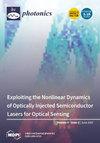捕获离子的马修-希尔方程稳定性分析:非线性电动力学陷阱的谐波修正
IF 2.1
4区 物理与天体物理
Q2 OPTICS
引用次数: 0
摘要
本文讨论了希尔方程的稳定性,特别是描述离子在电动捕集器中运动的马修方程的稳定性。通过采用 Floquet 理论和希尔法求解,得到了一个无限的线性均质方程组,其系数是递归确定的。讨论了参数 a 和 q 为实数时的稳定性。对于著名的偶数和奇数马修方程 cem(z,q) 和 sem(z,q),通过 Sturm-Liouville 问题自然引入了特性曲线。在保罗陷阱的情况下,稳定解对应于谐波运动的叠加。我们推导出理想条件下(考虑在内)稳定振荡的最大振幅。我们说明了组合(保罗和潘宁)陷阱的稳定图,并表示了轴向和径向运动的稳定域边界,其中前者由典型的马修方程描述。我们在扰动理论框架内讨论了非线性保罗陷阱的谐波修正,而修正后的稳定域边界是作为所选扰动参数的函数确定的,我们证明它们向参数负值移动。这些结果的应用包括但不限于二维和三维离子阱的不同应用,如质谱分析(包括纳米粒子)、高分辨率原子光谱分析和量子工程应用,其中我们提到了光学原子钟和量子频率计量学。本文章由计算机程序翻译,如有差异,请以英文原文为准。
Mathieu–Hill Equation Stability Analysis for Trapped Ions: Anharmonic Corrections for Nonlinear Electrodynamic Traps
The stability properties of the Hill equation are discussed, especially those of the Mathieu equation that characterize ion motion in electrodynamic traps. The solutions of the Mathieu-Hill equation for a trapped ion are characterized by employing the Floquet theory and Hill’s method solution, which yields an infinite system of linear and homogeneous equations whose coefficients are recursively determined. Stability is discussed for parameters a and q that are real. Characteristic curves are introduced naturally by the Sturm–Liouville problem for the well-known even and odd Mathieu equations cem(z,q) and sem(z,q). In the case of a Paul trap, the stable solution corresponds to a superposition of harmonic motions. The maximum amplitude of stable oscillations for ideal conditions (taken into consideration) is derived. We illustrate the stability diagram for a combined (Paul and Penning) trap and represent the frontiers of the stability domains for both axial and radial motion, where the former is described by the canonical Mathieu equation. Anharmonic corrections for nonlinear Paul traps are discussed within the frame of perturbation theory, while the frontiers of the modified stability domains are determined as a function of the chosen perturbation parameter and we demonstrate they are shifted towards negative values of the a parameter. The applications of the results include but are not restricted to 2D and 3D ion traps used for different applications such as mass spectrometry (including nanoparticles), high resolution atomic spectroscopy and quantum engineering applications, among which we mention optical atomic clocks and quantum frequency metrology.
求助全文
通过发布文献求助,成功后即可免费获取论文全文。
去求助
来源期刊

Photonics
Physics and Astronomy-Instrumentation
CiteScore
2.60
自引率
20.80%
发文量
817
审稿时长
8 weeks
期刊介绍:
Photonics (ISSN 2304-6732) aims at a fast turn around time for peer-reviewing manuscripts and producing accepted articles. The online-only and open access nature of the journal will allow for a speedy and wide circulation of your research as well as review articles. We aim at establishing Photonics as a leading venue for publishing high impact fundamental research but also applications of optics and photonics. The journal particularly welcomes both theoretical (simulation) and experimental research. Our aim is to encourage scientists to publish their experimental and theoretical results in as much detail as possible. There is no restriction on the length of the papers. The full experimental details must be provided so that the results can be reproduced. Electronic files and software regarding the full details of the calculation and experimental procedure, if unable to be published in a normal way, can be deposited as supplementary material.
 求助内容:
求助内容: 应助结果提醒方式:
应助结果提醒方式:


